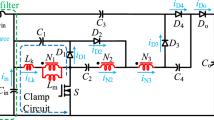Abstract
In this paper, a new non-isolated DC-DC converter is proposed. This converter topology is a high step-up boost converter with an extended voltage multiplier cell and a Cuk converter as a series output module. Compared to its high step-up counterpart, the proposed converter has a higher voltage gain. In this converter, an active clamp circuit is used to absorb the energy of leakage inductor, therefore, the ZVS turn on/off for switches and ZCS for diodes are achieved. The voltage stresses on the switches are low, and the reverse-recovery problem of the diodes is eliminated. The operational principle and characteristics of the proposed converter are presented. The analytical and simulated results are validated using a 200 W prototype converter with 20 V input and 400 V output operating at 100 kH.













Similar content being viewed by others
Change history
30 November 2021
A Correction to this paper has been published: https://doi.org/10.1007/s00202-021-01450-y
References
Li W, He X (2011) Review of nonisolated high-step-up DC/DC converters in photovoltaic grid-connected applications. IEEE Trans Ind Electron 58(4):1239–1250. https://doi.org/10.1109/TIE.2010.2049715
Gopi RR, Sreejith S (2018) Converter topologies in photovoltaic applications–A review. Renew Sustain Energy Rev 94:1–14
Hassan W, Lu DD-C, Xiao W (2019) Single-switch high step-up DC–DC converter with low and steady switch voltage stress. IEEE Trans Ind Electron 66(12):9326–9338
Ai J, Lin M (2016) Ultralarge gain step-up coupled-inductor DC–DC converter with an asymmetric voltage multiplier network for a sustainable energy system. IEEE Trans Power Electron 32(9):6896–6903
Ardi H, Ajami A, Sabahi M (2017) A novel high step-up DC–DC converter with continuous input current integrating coupled inductor for renewable energy applications. IEEE Trans Ind Electron 65(2):1306–1315
Andrade AMSS, Schuch L, da Silva ML (2018) Analysis and design of high-efficiency hybrid high step-up dc–dc converter for distributed pv generation systems. IEEE Trans Ind Electron 66(5):3860–3868
Azizkandi ME, Sedaghati F, Shayeghi H, Blaabjerg F (2019) A high voltage gain DC-DC converter based on three winding coupled inductor and voltage multiplier cell. IEEE Trans Power Electron 35(5):4558–4567
Chen S-M, Lao M-L, Hsieh Y-H, Liang T-J, Chen K-H (2014) A novel switched-coupled-inductor DC–DC step-up converter and its derivatives. IEEE Trans Ind Appl 51(1):309–314
Pourjafar S, Shayeghi H, Kojabadi HM, Maalandish M, Sedaghati F (2020) A coupled inductor based high voltage gain DC-DC converter using interleaved voltage multiplier cells. Iran J Electr Electron Eng 16(1):1–12
Yu D, Yang J, Xu R, Xia Z, Iu HH-C, Fernando T (2018) A family of module-integrated high step-up converters with dual coupled inductors. IEEE Access 6:16256–16266
Lee S, Park J, Choi S (2011) A three-phase current-fed push-pull DC–DC converter with active clamp for fuel cell applications. IEEE Trans Power Electron 26(8):2266–2277. https://doi.org/10.1109/TPEL.2010.2096477
de Paula WJ, de Oliveira Jr DS, de Pereira DC, Tofoli FL (2015) Survey on non-isolated high-voltage step-up dc–dc topologies based on the boost converter. IET Power Electron 8(10):2044–2057. https://doi.org/10.1049/iet-pel.2014.0605
Yazdani MR, Farzanehfard H, Faiz J (2011) Classification and comparison of EMI mitigation techniques in switching power converters-a review. J Power Electron 11(5):767–777
Lin B-R, Huang Y-S (2010) ZVS double-ended Ćuk converter. IEEE Trans Circuits Syst II Express Briefs 57(11):908–912
Pires VF, Foito D, Baptista FRB, Silva JF (2016) A photovoltaic generator system with a DC/DC converter based on an integrated Boost-Ćuk topology. Sol Energy 136:1–9
Pires VF, Cordeiro A, Foito D, Silva JF (2019) High step-up DC–DC converter for fuel cell vehicles based on merged quadratic Boost–Ćuk. IEEE Trans Veh Technol 68(8):7521–7530
Author information
Authors and Affiliations
Corresponding author
Additional information
Publisher's Note
Springer Nature remains neutral with regard to jurisdictional claims in published maps and institutional affiliations.
The original online version of this article was published with incomplete affiliation and this has been revised.
Rights and permissions
About this article
Cite this article
Jalili, J., Mirtalaei, S.M.M., Mohammadi, M.R. et al. A ZVS high step-up converter based on an integrated boost-cuk topology. Electr Eng 104, 807–816 (2022). https://doi.org/10.1007/s00202-021-01340-3
Received:
Accepted:
Published:
Issue Date:
DOI: https://doi.org/10.1007/s00202-021-01340-3




